
Termites, Cockroaches And Spiders can run but they can't hide from Micropest Pest Control Sydney.








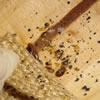



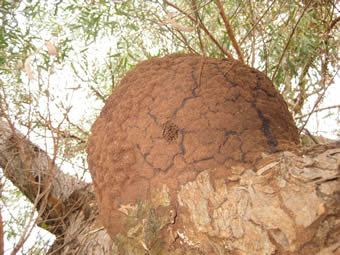
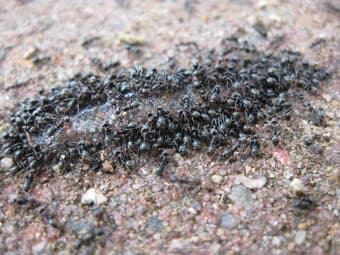
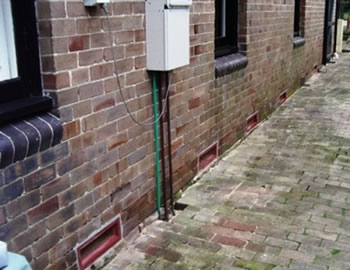
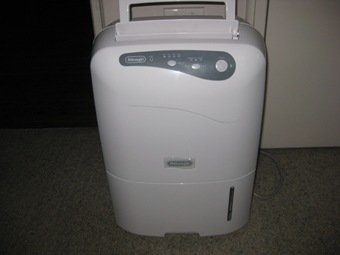


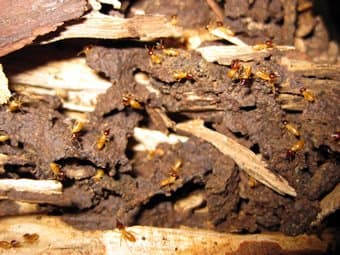
|
The Ongoing Australian Fight against Rising DampRising damp is a common issue in buildings and structures made from porous materials including brick, stone, and mortar. This issue gets its name from the way moisture slowly rises up through these materials via a process known as capillary action. Capillary action refers to a scientific phenomenon where moisture can essentially disobey gravity, flowing up through small tubes or pores in the building materials. When Micropest pest control Sydney conducts a termite inspection we also include a rising damp inspection. If a house has a moisture problem in the walls it quite often has sub-floor ventilation issues as well. Rising damp occurs in the lower portion of walls, and can affect areas of between .5 and 1.5 metres above the ground. It is often visible on walls by way of a ‘tide mark’. This term refers to an obvious line where the rising damp ends. This line occurs due to the deposits of salt that occur when moisture rises up through walls affected by rising damp; when the water evaporates, a line of salt remains. Rising damp is also evident through a number of other building-related symptoms, including crumbling and cracking of masonry and building materials, and damage to paint and wall paper. The degree of rising damp found in a given structure can vary depending on how porous the materials from which the building is constructed are, and also the degree of evaporation that occurs around the structure: rising damp issues may be exacerbated depending on the time of the year. When evaporation occurs, more moisture is drawn up through the wall, exacerbating the problem. The type of mortar used in construction can also have an effect on the extent to which rising damp becomes an issue in a building or structure. Rising damp is not a new issue, having been documented by scholars such as Vitruvius in Ancient Rome. Literature from the UK dating from the 19th century also discusses the ongoing threat of rising damp, particularly in moist, humid, or water-logged areas. Concerns about the effect of rising damp on occupants' health were also raised during these times, and continue to be a concern today, with some expressing concerns that rising damp encourages mould growth, stuffiness, and mustiness which can in turn result in health issues such as asthma and other breathing difficulties. Physical Damp Course DIY VideoThe Symptoms of Rising DampRising damp is evident via a number of primary and secondary symptoms. The primary symptoms that indicate that a building is affected by rising damp include visible moisture in the affected walls, often topped by a ‘tide line’ caused by salt deposits. The wall may also show signs of cracking, crumbling or other issues associated with deterioration. Rising damp can cause problems to internal walls as well as external walls. If the wall is covered by materials such as paint, wallpaper, or bagging or rendering, these may show signs of decay or disrepair. Paint may begin to peel or discolour, or may develop a shiny appearance. Wallpaper may begin to peel away or show signs of bubbling, while mortar may begin to crumble away from the moisture, leaving evident traces of residue and dust around the affected area. Skirting boards and floorboards may also begin to show signs of warping or rotting, while plaster may begin to show signs of flaking or bubbling. Other building materials may also show signs of damage from the increased presence of moisture in the property. Hinges or other fasteners may begin to show signs of rust, corrosion, or other signs of oxidisation such as ‘verdigris’. Similarly, door frames and window frames may also begin to weaken or swell from the effects of excess moisture, and furniture and wall hangings may also show signs of dilapidation or decay. Some damp wooden objects may also emit a noticeable odour, and affected wallpapers may do the same, particularly if excess mould growth is present. Moisture encourages the growth of mould, and affected buildings may show signs of fungi and mildew growth. These may be visibly evident: often mould and mildew leave dark, spotted stains around the affected area. Mould and mildew spores, however, can also become airborne, affecting the air quality of the building. The building may seem stuffy and damp as a result. This may cause illness or discomfort in the building's inhabitants, and may induce asthma attacks or other respiratory illnesses or allergic reactions in some individuals, with coughing and wheezing common among those affected by poor air quality. Identifying Rising DampWith rising damp having such a long history, it's no surprise that there are a myriad of approaches to identifying its presence. However, it should be noted that not all moisture in a building is caused by rising damp: some moisture issues arise from high levels of humidity within a building, often caused by poor ventilation, while others may be due to damage from rain or leaking pipes. An experienced damp control expert will be able to isolate the affected walls in your property, and will also be able to determine the likely cause of the moisture damage. Rising damp problems are often initially identified using preliminary “standing water” tests. Removing these sources of dampness, such as by using a dehumidifier, should eliminate simple damp problems caused by penetrating or falling dampness. If the dampness remains, then further tests and examinations can be undertaken to determine whether the issue is caused by rising damp. If a damp-proof course has been installed beneath the wall, then it is possible that the issue is not rising damp, for example, and that other issues such as a broken pipe may be to blame. Visual signs of rising damp, such as evident moisture levels between half and one and a half metres above the ground, as well as evident salt lines can be used as preliminary indicators of rising damp. Evidence of mould is also often indicative of the presence of rising damp. If these symptoms are present, then a rising damp expert may obtain a mortar sample using a hand-held moisture meter. These devices identify the degree of moisture build-up within the wall, and their diagnosis can be used to guide the type of treatment that might be required. The presence of moisture and salt in this sample can help determine the degree of moisture penetration present in the wall, and can also be helpful in determining the source of the moisture problem. Once the source and severity of the moisture have been determined, your rising damp expert may be able to provide you with recommendations about whether structural repairs are needed, or whether approaches such as the replacement of a damp-proof course may be required. Preventing and Treating Rising Damp with a Physical Damp CourseDespite its prevalence, rising damp isn't an unconquerable foe. In many instances rising damp can be prevented via a few simple methods during the architectural design and building processes. One of the most common preventative methods used in combating rising damp is the installation of a damp-proof course in the building's brickwork. A damp-proof course, also known as a DPC, comprises a waterproof barrier that is incorporated during construction. DPCs are usually built into the wall base just below the lowest section of timber in the wall. They can also be installed into concrete slabs during construction. These barriers prevent water from being able to seep up through the walls using the capillary method, and help to protect buildings from the effects of rising damp. TherE helpful methods that can be used to combat rising damp include checking plumbing for any leaks and having them repaired if necessary, and ensuring that there is adequate drainage around the property, particularly if the property is surrounded by paths or garden beds that may encourage water run-off. Maintaining gutters and keeping ventilation in good repair can also be helpful in staving off rising damp. However, it should be noted that changing the drainage approaches around a building built on a clay base may result in cracking: your damp control expert will be able to advise you about safe options for proceeding. Rising damp can also be treated by replacing a damp-proof course if the existing one has failed, something that is a possibility in older houses. Other methods for managing rising damp include a DPC injection, which involves inserting an application of a liquid damp-proofing agent, or the use of an electrical osmosis system. Electrical osmosis systems are inserted into the affected walls, after which point an electrical charge is applied. The application of the charge dries out the affected wall, and helps to prevent moisture from occurring again in the future. Angled porous ceramic tubes can also be inserted into an affected wall to help soak up moisture from mortar and the surrounding brickwork or stone masonry. The tilt of these tubes encourages water to drop to the open bottom of the tube, where it evaporates, drying out the rising damp-affected wall. Chemical Injection Approaches to Treating Rising DampAlthough all new homes in Australia must have a damp-proof course installed during the construction process, many older homes lack such a course. And in cases where the initial damp-proof course has been incorrectly inserted, the course may fail, potentially resulting in rising damp. Fortunately, rising damp can be managed even after the construction process has been completed. One approach to treating rising damp is the chemical pressure approach. Before a chemical pressure injection is carried out on a rising damp-affected property, a team of damp control specialists will undertake a thorough survey of the affected property. This is to determine the degree of dampness within the structure, as well as to determine whether the cause of the damp is rising damp, or whether it is another type of damp such as falling damp or penetrative damp. Once rising damp has been identified as the culprit behind the property's moisture problems, an electronic moisture meter can be used to analyse the moisture penetration in the building. The damp control experts will then prepare the property for the chemical pressure injection. Depending on the property, render and other wall coverings may need to be removed in order to apply the injection. However, this preparation will usually only involve those walls affected by rising damp. Exposed brick work will usually not require this type of treatment. If your home is heritage protected, you may need to consult with your local council about proceeding. Once the walls have been prepared, the chemical pressure injection will be applied. The injection will be undertaken using a specially developed system of pumps, ensuring a mess-free result. The product used is odourless and environmentally sound, and will not require evacuation by the residents. Once the injection has ‘set’, the damp-proof course application is complete, and the property will be protected from further issues from rising damp. Once the process is complete, all debris and materials will be removed from the property. However, depending on the degree of preparation work involved, and as these chemical materials may have an effect on the colouration of plaster or render, re-plastering or rendering may be required. Our Locations WahroongaAddress: 24/24-36 Pacific Highway, Wahroonga N.S.W 2076 Phone:1300 243 377 Hours: Open 7 days, 7 am–10 pm We provide the same day emergency services for the Upper North Shore suburbs of Wahroonga, Pymble, Hornsby, Turramurra, Westleigh and Thornleigh. BerowraAddress:111 Yallambee Road Berowra, Sydney N.S.W 2081. Phone:(02) 9489 0013 Hours: Open 7 days, 7 am–10 pm We provide the same day emergency services for Berowra, Galston, Arcadia, Brooklyn, Mt White, Mt Colah and Asquith. ArtarmonAddress: 43 Whiting St, Artarmon NSW 2064 Phone:1300 884 166 Hours: Open 7 days, 7 am–10 pm We provide the same day emergency services for the Lower North Shore suburbs of Artarmon, Chatswood, Lane Cove, Roseville, Lindfield, Killara, North Sydney, Neutral Bay, North Bridge and Castlecrag. |

|
|||||||